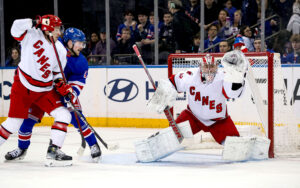If a puck is cleared out of the zone and trickles in on the opposing goalie, is it a shot on goal? If a player is rubbed out along the boards, is it a hit? How about if a point shot is deflected out of play by a defenceman’s outreached stick? Is that a blocked shot? Although they aren’t supposed to be, these stats are subjective and yet, they play a huge part in the fantasy hockey world. If you’re an avid fantasy player, you can recall a time where you needed a single hit on a Sunday to win your matchup. Little did you know that if your player was in PPG Paints Arena in Pittsburgh, he would almost certainly have received the hit you so desperately needed. But, if instead, he was at the Xcel Energy Center in Minnesota – a place that seems to only count hits if somebody is on the ground, he probably wouldn’t have. Well, we can’t change this problem. But what we can do is make sure that we know the discrepancies from rink to rink and use these arena statistics to our advantage.
Arena Statistics – Hits
Of the three most subjective categories used in fantasy hockey leagues, hits are the most inconsistently recorded stat around the NHL. For the second year in a row, PPG Paints Arena ranked highest in total hits per game with 63.96. This means that when the Pittsburgh Penguins are home, the game on average has nearly 64 hits in total. The Pens actually average eight more hits at home than they do on the road. The second-highest ranked arena for hits per game is the United Center with 61.14. The Chicago Blackhawks averaged nearly 12 more hits per game at home than they do on the road. Both the Penguins and the Blackhawks don’t necessarily play a bruising style of hockey, so something must be up, right?
The flipside makes it more obvious. For the second year in a row, the Xcel Energy Center ranked 31st in hits per game with only 28.43. Meaning on average, a game in Pittsburgh had 35.54 more hits in it than a game in Minnesota. Other arenas that aren’t too generous with hits are KeyBank Center in Buffalo (29.43) and Ball Arena in Colorado (30.18).
Of course, the players on the team do play a part in this. Acquisitions like Radko Gudas, Patric Hornqvist and later, Sam Bennett helped the Florida Panthers‘ BB&T Arena jump from 24th to third in hits per arena. It’s clear though that some arenas (like Chicago’s and Pittsburgh’s) hand out hits like Oprah hands out gifts, so it’s important to remember this when projecting the season of a player moving from one team to another. For example, you can bet on Seth Jones’s hit totals going up next season.
Arena Statistics – Blocked Shots
Blocks is another subjective stat that poolies have added to their leagues in recent years. The difference from arena to arena isn’t as drastic as it is for hits as the definition of a blocked shot is a little clearer. Still, there are some outliers that are worth noting.
T-Mobile Arena, home of the Vegas Golden Knights, ranks first in total blocks per game with 33.50. You may be thinking that makes sense. Teams come in and need to block more shots against a formidable opponent in Vegas. That’s partly true, but it’s interesting that Vegas averages as many blocks at home as their opponents do when they come to town. As a matter of fact, no arena in the NHL has more road team blocked shots than T-Mobile. The United Center tallies up blocks generously as well. It’s the only other NHL arena that has more than 30 per game with 31.
Then there’s the other side of the equation. The Prudential Center in New Jersey and the Scotiabank Saddledome in Calgary have 20.93 and 21.11 blocks per game respectively, ranking 31st and 30th in the league. The New Jersey Devils and the Calgary Flames are the only teams to have fewer than 10 blocks per game at home. Because of this, they have the widest margin between home blocks and roadblocks where the average differs by more than four blocks.
So, it’s Sunday and you’re looking to catch up in blocked shots in your head-to-head matchup? Consider picking up a player who’s playing in Vegas.
Arena Statistics – Shots on Goal
Unlike hits or blocks, shots have been recorded forever. This makes their recording inconsistencies a little more troubling. It also affects more than just shot totals, as goalies benefit from playing in arenas that are generous too. Surely Sergei Bobrovsky would have seen a sub .900 save percentage in at least one of the past two seasons, right? Wrong. The BB&T Center in Florida hands out shots like candy on Halloween, so Bobrovsky has been able to maintain respectable totals despite his inconsistent play. The average game in Florida has a whopping 67.30 shots. Meanwhile, the United Center also continues to rank at or near the top as shot totals on average in Chicago are 65.60 per game. Both arenas have ranked in the top two for the past two seasons.
Last year, the American Airlines Center in Dallas ranked last among all teams. The average game hosted by the Dallas Stars had 54.40 shots. What’s crazier is that the Stars outshot their opponents at home by nearly five shots per game. Visiting teams were only able to muster an average of 24.90 shots on goal. The Flames, Wild, Devils, Coyotes and Lightning all ranked towards the bottom of the league averaging about 56 shots per home game.
Looking ahead to the upcoming season (with this data in our back pocket), we can make educated assumptions. For instance, Sam Bennett’s shots/60 is likely going to improve. Heck, Marc-Andre Fleury might even be up for the Vezina once again! (Though this is a little more far-fetched). Just remember that little things like knowing which arenas are generous with stats and which are stingy can potentially give you the edge to win your fantasy leagues.
Interested in viewing the full arena statistics analysis? Contact the Fantasy Hockey Bros on Twitter or Instagram.






